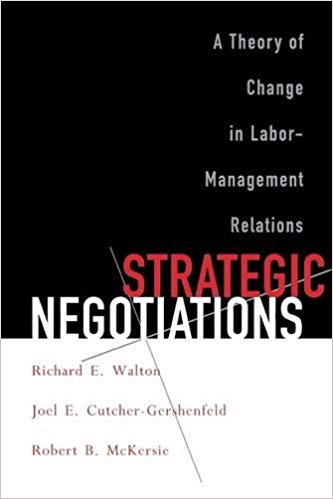Labor-management relations have changed dramatically in recent years. Global competition and related economic, technological, political, and institutional changes have forced the collapse of the traditional social compact—based on steadily increasing wages and benefits for workers in exchange for unchallenged managerial autonomy—underpinning the U.S. labor market. In today’s competitive environment, managers can no longer afford the costs inherent in this compact and are striving to change their relationship with labor to achieve competitive advantages such as lower cost, increased operational flexibility, employee commitment, and improved customer service. Labor leaders respond to these new pressures by aggressively protecting past wage and benefit gains, emphasizing job security, and working to assure the institutional security of the union. In Strategic Negotiations, the authors look at the contract negotiation process to explain exactly how the renegotiation of the social compact is being achieved.
Strategic Negotiations identifies three fundamental negotiating strategies that are being used to effect changes in labor-management relations. The first, called forcing, involves making labor accept unwanted substantive terms while simultaneously reducing the union’s influence in the workplace. In contrast, the second strategy of fostering emphasizes finding solutions to common problems and building trust and consensus between the parties. The third strategy, escape, entails withdrawing from the negotiating relationship altogether by physically transferring operations to another location. Using detailed case studies of individual firms and entire industries to analyze the tactical advantages and risks of each approach, the authors ultimately recommend a mixed strategy of forcing and fostering.
The book is divided into three sections. Part I reviews the contemporary labor-management landscape and presents the authors’ theory about how the strategies are being used to reshape relationships between American management and labor. Part II offers case histories of thirteen companies drawn from the pulp and paper, auto supply, and railroad industries to illustrate that theory. Part III examines the case studies in greater depth to assess the influences on the negotiators and their ensuing strategic choices, and Part IV identifies the specific tactics companies use to implement their negotiating strategies.
Throughout the book, the authors note evidence that explains why certain negotiations were successful while others failed, and provide guidelines to help practitioners decide which strategy or combination of strategies is best for their situation. While labor and management must continue to attend to their different and often conflicting interests, each must give equal or greater attention to the parties’ common interests to survive in today’s competitive business arena. By establishing a clear framework for understanding how the U.S. labor market is evolving, this book offers the parties a way to address both their differences and their expanding mutual interests.
Strategic Negotiations: A Theory of Change in Labor-Management Relations Attributes
| Author: | Richard E. Walton, Joel E. Cutcher-Gershenfeld, and Robert B. McKersie |
|---|---|
| Publisher: | Boston, MA: Harvard Business School Press, 1994 |

